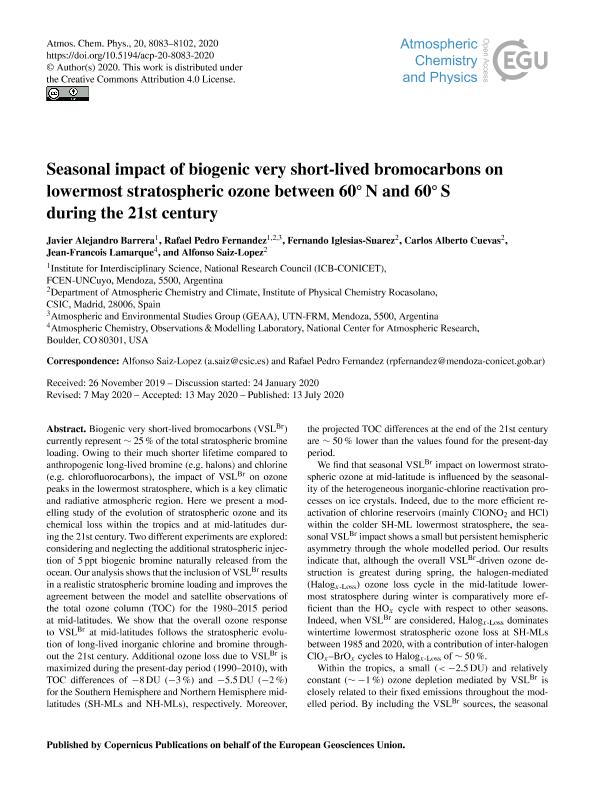Artículo
Seasonal impact of biogenic very short-lived bromocarbons on lowermost stratospheric ozone between 60° N and 60° S during the 21st century
Barrera, Javier Alejandro ; Fernandez, Rafael Pedro
; Fernandez, Rafael Pedro ; Iglesias Suarez, Fernando; Cuevas, Carlos Alberto; Lamarque, Jean Francois; Saiz-lopez, Alfonso
; Iglesias Suarez, Fernando; Cuevas, Carlos Alberto; Lamarque, Jean Francois; Saiz-lopez, Alfonso
 ; Fernandez, Rafael Pedro
; Fernandez, Rafael Pedro ; Iglesias Suarez, Fernando; Cuevas, Carlos Alberto; Lamarque, Jean Francois; Saiz-lopez, Alfonso
; Iglesias Suarez, Fernando; Cuevas, Carlos Alberto; Lamarque, Jean Francois; Saiz-lopez, Alfonso
Fecha de publicación:
07/2020
Editorial:
Copernicus Publications
Revista:
Atmospheric Chemistry and Physics
e-ISSN:
1680-7324
Idioma:
Inglés
Tipo de recurso:
Artículo publicado
Clasificación temática:
Resumen
Biogenic very short-lived bromocarbons (VSLBr) currently represent ∼25 % of the total stratospheric bromine loading. Owing to their much shorter lifetime compared to anthropogenic long-lived bromine (e.g. halons) and chlorine (e.g. chlorofluorocarbons), the impact of VSLBr on ozone peaks in the lowermost stratosphere, which is a key climatic and radiative atmospheric region. Here we present a modelling study of the evolution of stratospheric ozone and its chemical loss within the tropics and at mid-latitudes during the 21st century. Two different experiments are explored: considering and neglecting the additional stratospheric injection of 5 ppt biogenic bromine naturally released from the ocean. Our analysis shows that the inclusion of VSLBr results in a realistic stratospheric bromine loading and improves the agreement between the model and satellite observations of the total ozone column (TOC) for the 1980?2015 period at mid-latitudes. We show that the overall ozone response to VSLBr at mid-latitudes follows the stratospheric evolution of long-lived inorganic chlorine and bromine throughout the 21st century. Additional ozone loss due to VSLBr is maximized during the present-day period (1990?2010), with TOC differences of −8 DU (−3 %) and −5.5 DU (−2 %) for the Southern Hemisphere and Northern Hemisphere mid-latitudes (SH-MLs and NH-MLs), respectively. Moreover, the projected TOC differences at the end of the 21st century are ∼50 % lower than the values found for the present-day period.We find that seasonal VSLBr impact on lowermost stratospheric ozone at mid-latitude is influenced by the seasonality of the heterogeneous inorganic-chlorine reactivation processes on ice crystals. Indeed, due to the more efficient reactivation of chlorine reservoirs (mainly ClONO2 and HCl) within the colder SH-ML lowermost stratosphere, the seasonal VSLBr impact shows a small but persistent hemispheric asymmetry through the whole modelled period. Our results indicate that, although the overall VSLBr-driven ozone destruction is greatest during spring, the halogen-mediated (Halogx-Loss) ozone loss cycle in the mid-latitude lowermost stratosphere during winter is comparatively more efficient than the HOx cycle with respect to other seasons. Indeed, when VSLBr are considered, Halogx-Loss dominates wintertime lowermost stratospheric ozone loss at SH-MLs between 1985 and 2020, with a contribution of inter-halogen ClOx?BrOx cycles to Halogx-Loss of ∼50 %.Within the tropics, a small (<−2.5 DU) and relatively constant (∼−1 %) ozone depletion mediated by VSLBr is closely related to their fixed emissions throughout the modelled period. By including the VSLBr sources, the seasonal Halogx-Loss contribution to lowermost stratospheric ozone loss is practically dominated by the BrOx cycle, reflecting the low sensitivity of very short-lived (VSL) bromine to background halogen abundances to drive tropical stratospheric ozone depletion. We conclude that the link between biogenic bromine sources and seasonal changes in heterogeneous chlorine reactivation is a key feature for future projections of mid-latitude lowermost stratospheric ozone during the 21st century.
Archivos asociados
Licencia
Identificadores
Colecciones
Articulos(CCT - MENDOZA)
Articulos de CTRO.CIENTIFICO TECNOL.CONICET - MENDOZA
Articulos de CTRO.CIENTIFICO TECNOL.CONICET - MENDOZA
Articulos(ICB)
Articulos de INSTITUTO INTERDISCIPLINARIO DE CIENCIAS BASICAS
Articulos de INSTITUTO INTERDISCIPLINARIO DE CIENCIAS BASICAS
Citación
Barrera, Javier Alejandro; Fernandez, Rafael Pedro; Iglesias Suarez, Fernando; Cuevas, Carlos Alberto; Lamarque, Jean Francois; et al.; Seasonal impact of biogenic very short-lived bromocarbons on lowermost stratospheric ozone between 60° N and 60° S during the 21st century; Copernicus Publications; Atmospheric Chemistry and Physics; 20; 13; 7-2020; 8083-8102
Compartir
Altmétricas



